|
GWR road vehicles and horse-drawn vehicles
by Mikkel Kjartan
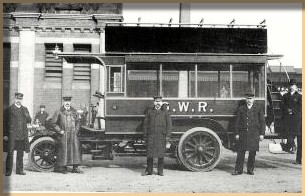
The first GWR double-decker: GWR No. 6 as running on the Slough-Windsor service from 1904 onwards. Seen here at Slough station
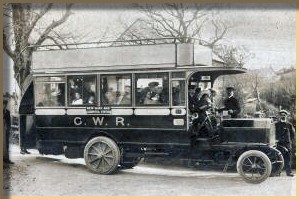
An early bus-service from Cardigan to New Quay, seen here in 1907
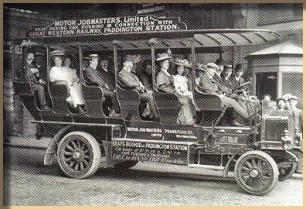
A charabanc (i.e. sideless bus) at Paddington station
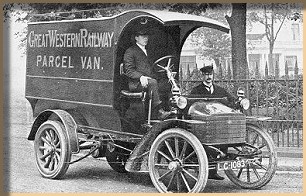
An early parcels delivery van
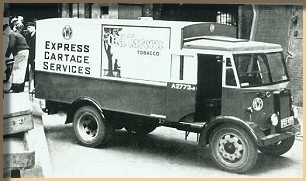
Development of the delivery van: A Thornycroft Express Cartage van in 1939
Photos from the authors's collection of old postcards
Introduction
The GWR operated an extensive system of road-vehicles in conjunction with its rail services.
This included numerous horse-drawn carts and flat-beds. The horse-drawn vehicles were usually constructed at Swindon and lasted in operation until just after WWII.
The GWR pioneered regular bus services in the UK with the introduction of its first motorbus from Helston to The Lizard in 1903. This was soon followed by doubledecker services at Torquay, Slough and elsewhere. GWR bus-services lasted until 1933, following a gradual handing over of routes to private companies.
The company also operated a large fleet of motorized vans and lorries for parcels delivery, goods transport etc.
As with buses, the vans and lorries tended to have the bodies built at Swindon while the chassis came from companies such as Mills-Daimler (especially pre-WWI), AEC and Thornycroft.
Liveries
Horse-drawn vehicles and early buses and vans were originally all-over chocolate, with blacks canvas tops where relevant and lettering in either white (canvas) or gold (bus sides).
The two-tone chocolate and cream colour was gradually introduced to both horse-drawn and motorized vans and busses, and was fully standard from 1923 onwards. This featured cream canvas tops and panelling above the waist-line, and chocolate below.
Most trailers and flat wagons had all-over brown sides throughout, as were steam rollers and steam tractors.
While busses carried standard "GWR" lettering (below the waistline),vans and lorries featured these same letters in unshaded block serif. From 1934 the shirt-button monogram was introduced on cab sides.
Vans usually has space set aside for carrying advertisements, and also often featured various slogans promoting the company.
References
There are a number of reference works for studying the road vehicles of the railway companies. These include:
P. Kelley "Road Vehicles of the Great Western Railway" and "Great Western Road Vehicles Appendix" OPC, 1973 (and reprints)
B. Aldridge & A. Earnshaw "Famous Fleets, Volume Four: Great Western Railway Road Vehicles" Trans-Pennine, 2000
J. Cummings, John "Railway Motor Buses and Bus Services in the British Isles 1902-1933" (2 Vols) OPC, 1980
Links
Some available kits and models
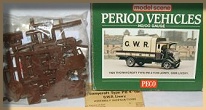
A number of kits for GWR road vehicles are available, although they often represent later types while early designs are harder to come by. This page illustrates a few examples of the more well-known kits.
Kits are available in both plastic and whitemetal, with a few also in etched brass. Note that the kits illustrated here are just a small sample. Other ranges include the Cooper-Craft 4mm AEC kits, while 2mm modellers may find something of use in e.g. the Fleetline range. Note that vehicle types used by the GWR are not always advertised as such in the kit ranges, but are often listed simply by the vehicle type and make.
Further examples of kits can be seen in Daryle Toney's page of models.
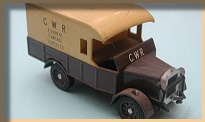
A 1/72 scale (HO) model of the 1½-ton Thorneycroft van used from 1920 to WWII. This is from the discontinued Keilkraft/Davric kit, still often available second-hand. The kit is overscale.
|
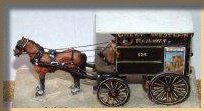
A one-horse parcels van. This one was built from a Langley 4mm whitemetal kit. |
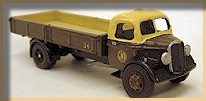
4mm Dodge dropside lorry of 1935 vintage, built from a Langley whitemetal kit.
|
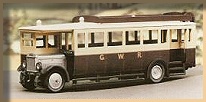
Maudsley ML3 bus to 4mm scale, built from the Peco/Merit plastic kit. This type was used until 1931.
|
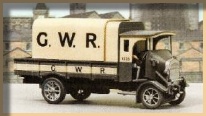
The Peco/Merit plastic kit for a Thorneycroft lorry, introduced in 1926.
|
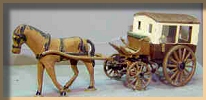
P&D Marsh 4mm whitemetal kit for a horse-drawn station bus, used from the 1890s.
|
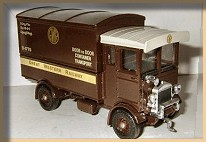
Models from the diecast ranges are also an option. Here is a Corgi Classics AEC 508 5 ton lorry in 1:43 scale, suitable for 7mm modelling. |
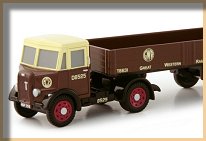
A Thornycroft "Nippy" from the Corgi range of 1:76 (4mm) diecast vehicles (available from March 2008). There is also a Horsebox van. |
A selection of vehicles and horse-drawn vehicles
7mm horse dray, built by Kevin Atkinson. This is actually a Slaters Plastikard kit for an LMS dray, kit-bashed into a GWR type.
The conversion was done using micro strip, Plastikard and Slater's brass wire. It was finished with Precision and Humbrol paints, and HMRS transfers. You can see more of Kevin's 7mm models in the GWR Showcase section. |
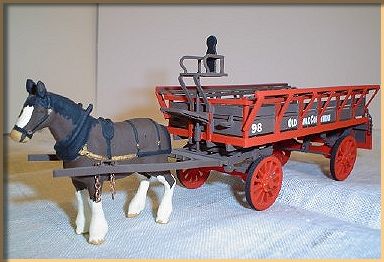
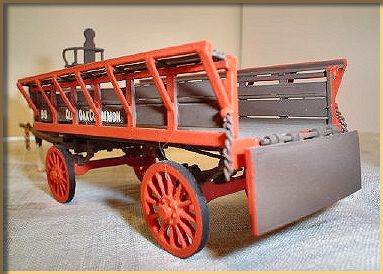 |
| GWR 4½-ton horse drawn delivery wagon No. 256, built from the Langley 7mm 4.5ton Horse Drawn Wagon white metal kit by an unknown modeller, with shire horses in front. Photos courtesy Eddie Holden. |
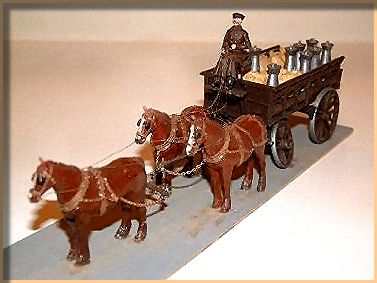
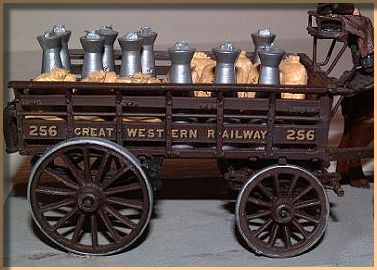
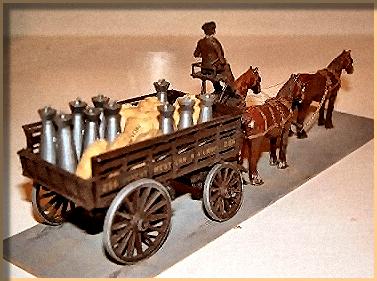 |
| This wonderful model shows a single horse drawn parcels collecting van, built in 1909 at Swindon works. The models was built by Geoff Butcher to the scale of 1½" to the foot. Many thanks to Tim Butcher for showing us these photos. |
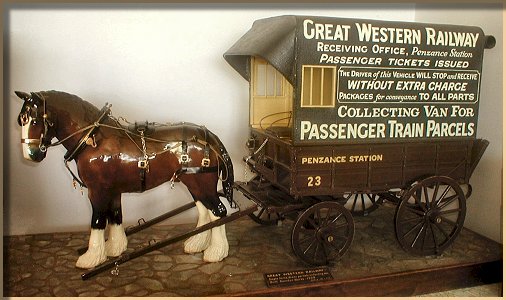
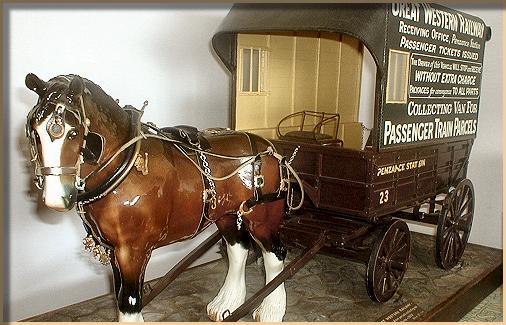
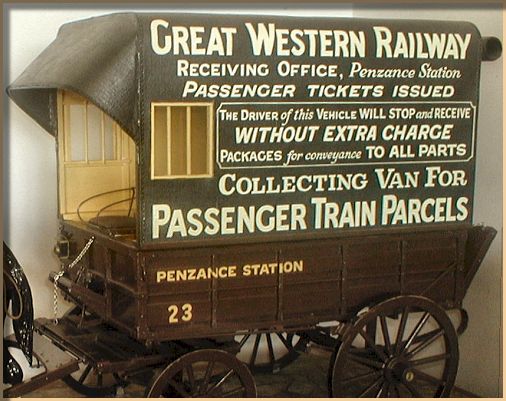 |
| These 2mm finescale models were scratch-built by Jerry Clifford, and are fine examples of craftmanship in this scale. |
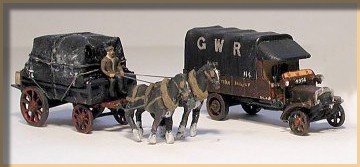
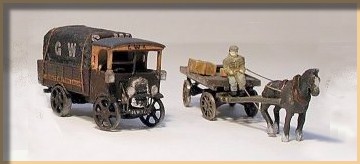 |
Here is a rather nice 7mm Scammell Mechanical Horse, made by an anonymous builder from the now obsolete Superscale Kit.
The Scammell company began as wheelwrights and coach builders in late Victorian London, introducing their first actual lorry in 1921.
The Mechanical Horse was developed in the late 1930s as a response to the need for a modern vehicle that could negotiate tight urban and industrial spaces. It soon found favor with the railway and dock companies, often directly replacing the good old not-so-mechanical common horse.
As with most things British, the Mechanical Horse naturally has its own enthusiasts' club. You can visit their website here.
Photos courtesy Milestone Miniatures. |
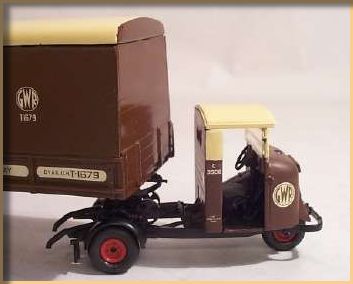
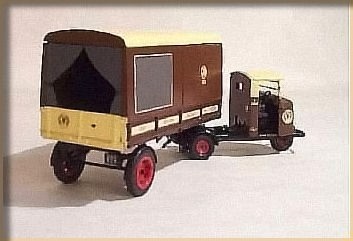
|
| A 4mm Foden steam wagon in GWR guise. The models seen here formed part of the former Mevagissey collection of railway models which has now been dismantled. |
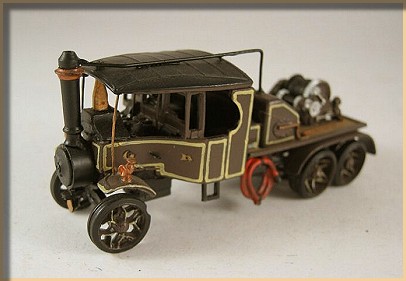 |
| Another 4mm Foden steam wagon, although here with a flatbed. |
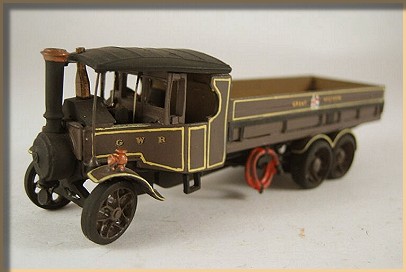 |
| A 4mm Thornycroft PB 4-ton lorry, introduced in 1926. |
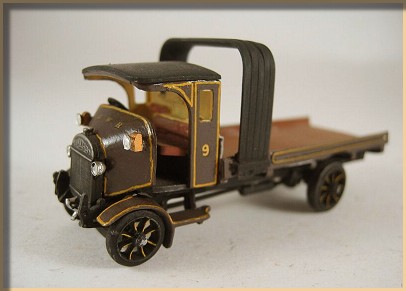 |
| A 4mm model of the Maudsley ML3 bus of 1927 vintage, bound for Helston station in Cornwall. |
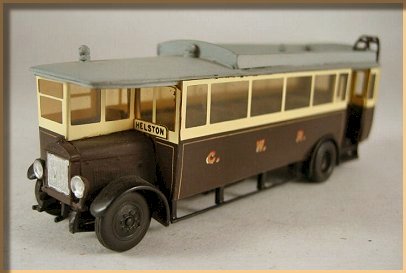 |
| An early Steam Tractor in GWR livery, also from the former Mevagissey collection |
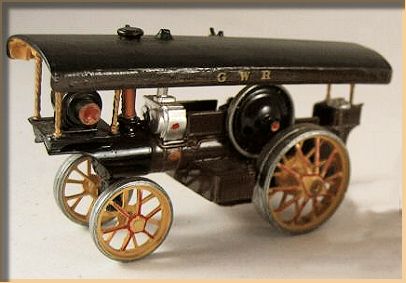 |
| A 7mm AEC lorry built from an unknown kit, showing the GWR roundel introduced on cabsides in 1934. |
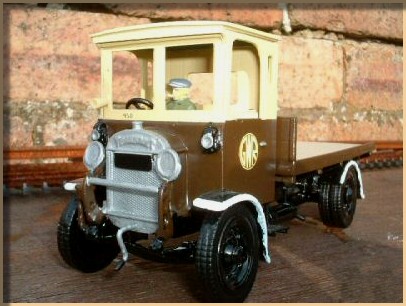 |
A rather nice 7mm Scammell Mechanical Horse, made by an anonymous builder from the now obsolete Superscale Kit. The Scammell company began as wheelwrights and coach builders in late Victorian London, introducing their first actual lorry in 1921.
The Mechanical Horse was developed in the late 1930s as a response to the need for a modern vehicle that could negotiate tight urban and industrial spaces. It soon found favor with the railway and dock companies, often directly replacing the good old not-so-mechanical common horse. As with most things British, the Mechanical Horse naturally has its own enthusiasts's club.
Photos courtesy Milestone Miniatures. |

 |
|































